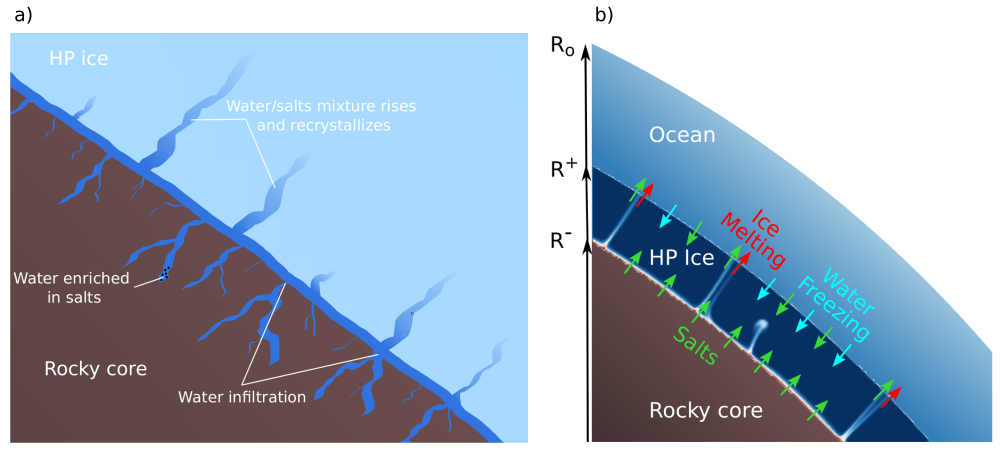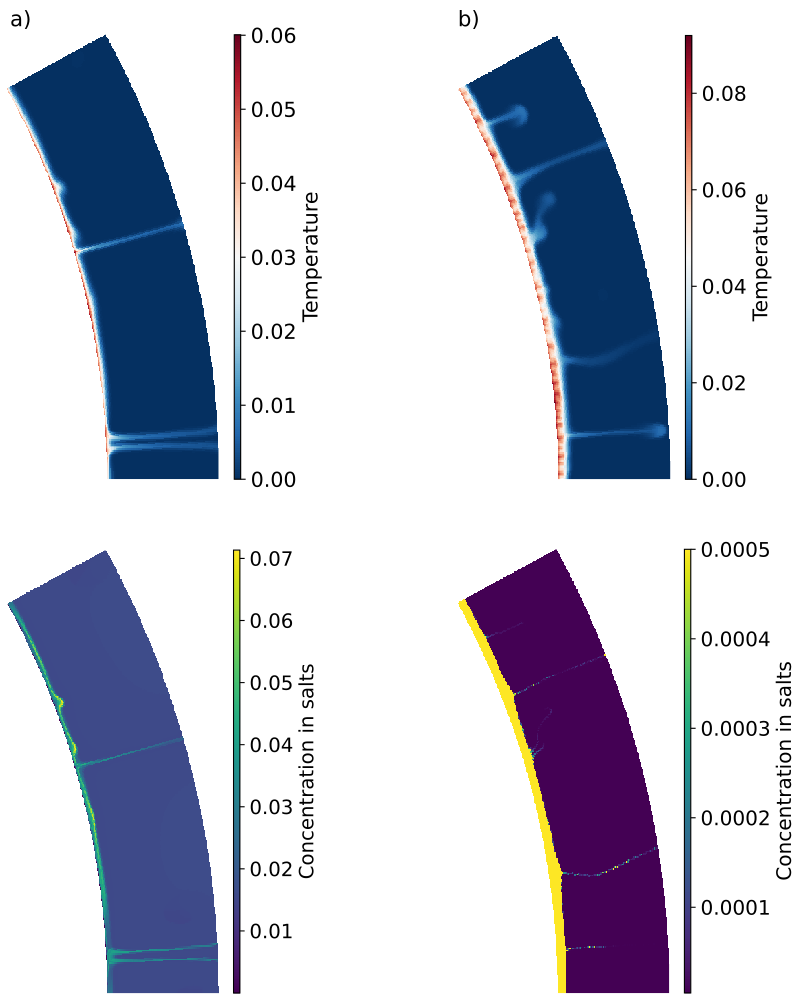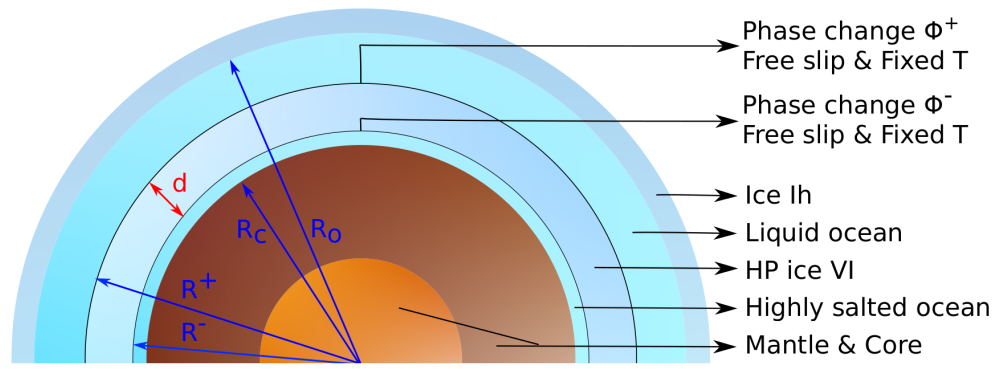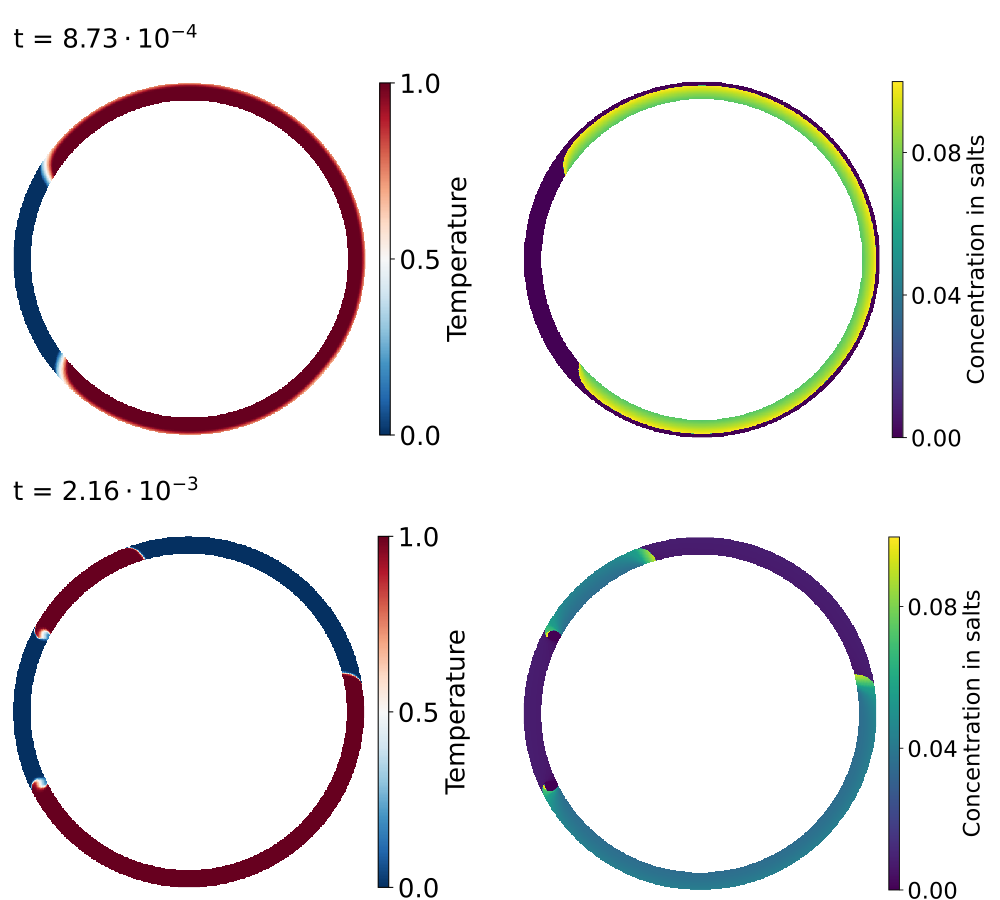Dynamics of high-pressure ice layers in large ocean worlds
- 1Department of Geophysics, Faculty of Mathematics and Physics, Charles University, V Holešovičkách 2, Prague, 18000, Czech Republic (lebec@karel.troja.mff.cuni.cz)
- 2LGLTPE, ENS Lyon, Université Claude Bernard, 46 allée d’Italie, Lyon, 69364, France
Ocean worlds seem to offer a very suitable environment for life appearance and sustainability and studying their internal dynamic is a key topic for exobiology. However, the ocean of large icy moons, such as Ganymede, has long been rejected as a potential habitat for life to develop. Due to pressure, a high-pressure (HP) ice layer should exist between the core and the ocean, preventing direct interactions and mass exchanges between both. Therefore, the HP ice layer dynamics has long been a relatively unexplored topic. However, several studies have been carried out in recent years ([1],[2],[3],[4],[5],[6]), each of them exploring one or several aspects of the problem, to characterize the possibility and efficiency of mass transfer between the core and the ocean. They all suggest that, under certain conditions, exchanges could happen by solid and/or liquid convection through this layer. In addition to helping us understand better the internal dynamics of such planetary bodies, these studies are of the utmost importance, as they concern bodies that could join the list of potentially habitable planets, but also because this layer of ice is likely to exist on large ocean exoplanets, which are highly interesting bodies for exobiology.
Previous studies ([1],[2],[3],[4],[5]) only considered pure water ice for the HP ice layer. However, the ocean of these moons is composed of salty water, which could originate from various processes, including core/ocean interactions. Therefore, in our last paper [6], we introduced salts to explore their effects on the overall dynamics. This work aims to characterise better the effectiveness of salt transfers between the core and the ocean and study ocean composition's evolution over time. Previous studies concluded that, in certain conditions, the heat flux from the core is sufficiently high for the temperature to reach the melting temperature at the HP ice/core boundary. As a result, pockets of melt could appear at the bottom of the HP ice layer, and water could seep into the core through fractures, enriching it with salts. (Fig1.a). If the salty water is less dense than pure ice, it should rise through the ice and could refreeze on the way, enriching the ice with salts. We considered a 2D HP ice layer with a flux of salts coming from the core (Fig1.b) and studied the exchanges of salts between the core and the ocean by solid convection. In this study, the salts are represented by Lagrangian tracers. This work gives a large panel of results, such as the influence of salts on the HP ice dynamics and their effect over time, as well as the evolution of the composition of salts in the ocean. One important result is that two distinct dynamic regimes can be observed depending on the buoyancy number. For what can be considered as low values of the buoyancy number (Fig2.a) the salts have nearly no effect on the ice density and they are passively transported to the ocean through upwelling hot plumes. Conversely, for high values of the buoyancy number (Fig2.b), salty ice is much denser than pure ice and accumulates at the bottom of the ice shell, and only a small fraction of salts reach the ocean. The switch between both regimes mainly depends on the Rayleigh number. For Ganymede, we obtained a radial velocity of the order of a meter per year at the HP ice/ocean interface, which is rather efficient and means that salts reaching the boundary should easily be dissolved in the ocean.
One of the dynamic outputs of study [6] is the possible existence of a thin and highly salted ocean between the HP ice layer and the core. This ocean could exist under specific conditions, in particular a sufficient amount of salts entering the HP ice layer from the core for the salty ice to accumulate at the bottom of the shell and melt it completely. We studied this particular case (Fig3) to better understand its implications on the HP ice layer dynamic and the efficiency of mass transfer between the core and the ocean. However, validating the feasibility of this hypothesis would require more information about the core composition in terms of chemical elements capable of forming salts. The results of this study (Fig4) show a very different flow pattern from the one we obtain for a model without a basal ocean (Fig2). It is dominated by a low-degree mode (fluctuating between one or two) with large cold downwelling and hot upwelling currents (Fig4). This could imply an important heat transfer through the layer and, if this basal ocean has existed at least punctually on such a moon as Ganymede, it could have significant implications for the ocean composition and tectonic evolution of the outer icy layer.

Fig1: a) Illustration of the enrichment of HP ice in salts thanks to interactions with the core. b) Model illustration.

Fig2 : Snapshots of 1/12 of the HP ice layer for a buoyancy number of a) 0 and b) 10.

Fig3 : Model illustration with a basal ocean.

Fig4 : Snapshots of the evolution of the HP ice layer in time.
[1]: Choblet, G et al., 2017, Icarus. http://dx.doi.org/10.1016/j.icarus.2016.12.002.
[2]: Kalousová, K., Sotin, C., 2018, Geophys. Res. Lett. http://dx.doi.org/10.1029/2018GL078889.
[3]: Kalousová, K., et al., 2018, Icarus. http://dx.doi.org/10.1016/j.icarus.2017.07.018.
[4]: Kalousová, K., Sotin, C., 2020, Earth Planet. Sci. Lett. http://dx.doi.org/10.1016/j.epsl.2020.116416.
[5]: Lebec, L. et al., 2023, Icarus. http://dx.doi.org/10.1016/j.icarus.2023.115494.
[6]: Lebec, L. et al., 2024, Icarus. https://doi.org/10.1016/j.icarus.2024.115966.
Acknowledgments: We would also like to thank Adrien Morison, Daniela P. Bolrão and Paul J. Tackley for their contribution to this work.
How to cite: Lebec, L. and Labrosse, S.: Dynamics of high-pressure ice layers in large ocean worlds, Europlanet Science Congress 2024, Berlin, Germany, 8–13 Sep 2024, EPSC2024-30, https://doi.org/10.5194/epsc2024-30, 2024.